The Complete Carpenter: They Live (1988)
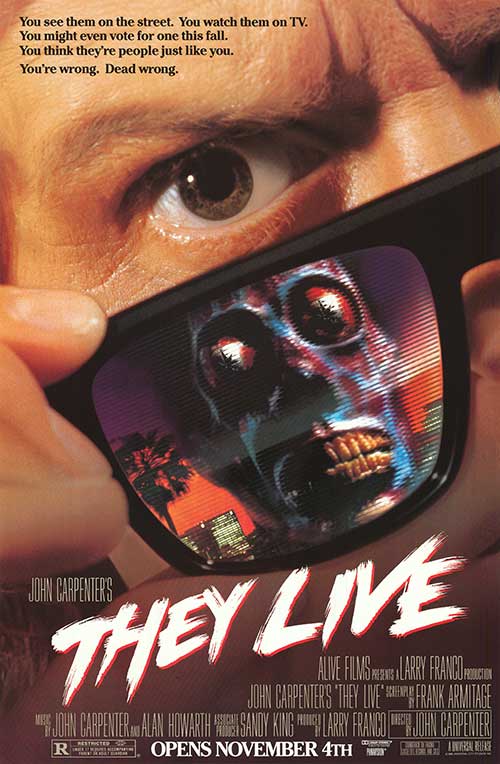 “What’s the threat? We all sell out every day. Might as well be on the winning team.”
“What’s the threat? We all sell out every day. Might as well be on the winning team.”
The career of John Carpenter spans four decades, but the 1980s was his special golden era. Although his ‘80s films may not have always succeeded at the box office, their run of quality is humbling: Escape from New York (1981), The Thing (1982), Big Trouble in Little China (1986), and Prince of Darkness (1987). While Christine (1983) and Starman (1984) aren’t in the same tier as that group, they’re good movies audiences still enjoy today.
No other film could have closed out the John Carpenter Decade better than They Live. It’s not only the last movie he made in the ‘80s, it serves as a DO NOT QUESTION AUTHORITY curtain closer on the entirety of the decade.
The Story
Only four characters in the movie have names, so let’s get the actor attributions out of the way: Nada (Roddy Piper), Frank Armitage (David Keith), Holly Thompson (Meg WATCH TV Foster), and Gilbert (Peter Jason). “Frank Armitage” is also Carpenter’s screenwriter pseudonym, giving the impression that a fictional character in the movie also wrote it. That nicely predicts the meta-horror of In the Mouth of Madness by six years.
Nada is a drifter who’s come to L.A. searching for work. He meets another construction worker, Frank, who introduces him to the shanty town and homeless shelter of Justiceville. There’s something strange going on under the surface of Justiceville, however, and Nada discovers the shelter organizers using a nearby church to develop strange science equipment — and a bunch of sunglasses, for some reason. After a suspiciously timed police raid demolishes Justiceville, Nada escapes and finds himself in possession of the sunglasses. When he puts on a pair, he can see the disturbing truth of the world: ghoulish alien creatures disguised as the rich and powerful actually rule the planet. They’ve peppered all visual media with subliminal messages of submission to mindless consumerism to cow the human population.
But Nada is all out of bubblegum and he ain’t having this. He gets Frank to work with him — after they savagely beat each other in a back alley for five minutes — and then seeks out the underground resistance. However, they’re not only facing alien invaders, but also the human collaborators who have sold out for their slice of ‘80s yuppiedom.
The Positives
Carpenter often put anti-authoritarian subtexts into his films, such as the satirical backdrops of the two Escape From… movies. But They Live is his most overtly political work. Often savagely so: here’s a movie that lingers on the image of police officers savagely beating a blind black preacher, and retrofits the famous political images of the era to feature corpse-like creatures preaching conformity. Horrifying, yes — but as a crazy SF movie it’s also totally rad. (See that? A period slang term. Yes, I lived through the ‘80s.) Nothing about it is subtle, OBEY but it’s John Carpenter at peak creativity using science fiction as a cloak to hide the ‘70s angry young man in an era that would prefer to sideline angry young anybody.
I’ll put it out there: I think They Live is a better, more acidic condemnation of the “Greed is Good” philosophy of capitalism without moral restraint than Oliver Stone’s Wall Street. (Come to think of it, Gordon Gecko is almost certainly one of Them.)
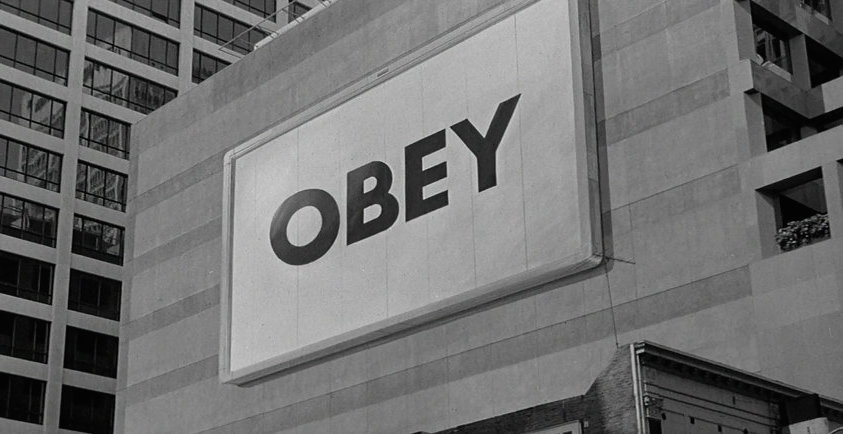 Released in the last year of the Reagan Administration, They Live is the vision of a director who grew to artistic maturity in the mindset of the rebellious 1970s, but is now surveying the landscape of the ‘80s and wondering, “What the hell happened?” This comes straight from Carpenter’s mouth: he wanted to use the formula of the 1950s paranoia SF movies but apply it to the rampant consumerism of the 1980s and the idea that people had fallen into complacency about the “Morning in America” myth.
Released in the last year of the Reagan Administration, They Live is the vision of a director who grew to artistic maturity in the mindset of the rebellious 1970s, but is now surveying the landscape of the ‘80s and wondering, “What the hell happened?” This comes straight from Carpenter’s mouth: he wanted to use the formula of the 1950s paranoia SF movies but apply it to the rampant consumerism of the 1980s and the idea that people had fallen into complacency about the “Morning in America” myth.
Carpenter doesn’t disguise the satire. MARRY AND REPRODUCE The alien invaders are referred to as “free enterprisers” who are interested in Earth as a third world country to plunder for resources. Some humans are willing to side with these overlords for a taste of the good life, hoping to get some of those trickle-down economic drops. The only possible heroes are the people at the bottom of the ladder, a fringe world of the homeless and community organizers with only enough power to hide in an abandoned church.
They Live retains power beyond the era it satirizes. In the director’s own words from a 2015 interview: “The same problem — unrestrained capitalism — still exists … The ‘80s never ended. The mentality that the ‘80s bred is really alive and well — that’s the part that’s so bad.” Like most great allegorical science-fiction, They Live has a way of reasserting its themes outside of its original time frame. It takes a skilled artist to create metaphors that endure, and Carpenter achieved this the way Rod Serling did with “The Monsters Are Due on Maple Street” for The Twilight Zone. The theme that underneath the norms of democracy lies despotism and oligarchy remains deeply troubling. There’s also the perennial notion that survival in the world means never upsetting the Way Things Are:
Frank: I’m walking a white line all the time. I don’t bother nobody. Nobody bothers me. You better start doing the same!
Nada: White line’s in the middle of the road. That’s the worst place to drive.
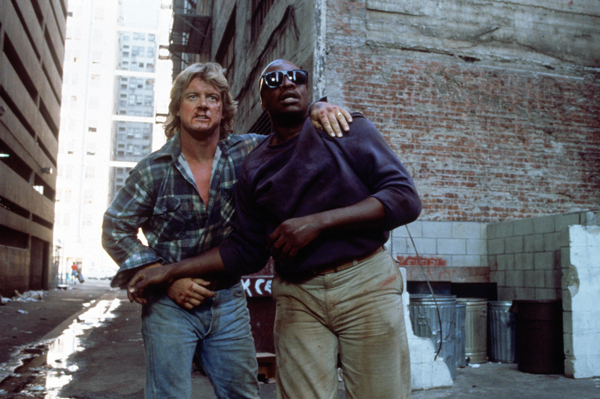 Nada is the “Awareness Hero” who pops up in so many John Carpenter films. CONSUME He immediately notices the strange activity around the church near Justiceville, and he’s given the most literal form of awareness when he first puts on the sunglasses — a terrific scene. But before donning the shades, Nada is as much subsumed under the cultural normalcy pitched as the American dream as everyone else. “I deliver a hard day’s work for my money. I just want the chance. It’ll come. I believe in America. I follow the rules.” Nada doesn’t know yet that the chance people in hard times are waiting for is an opportunity to make a Faustian deal to sell out human freedom — the deal the drifter (Buck Flower) and all the power players make. It’s no accident Carpenter used “I believe in America,” the first line from The Godfather, in Nada’s pathetic statement of purpose.
Nada is the “Awareness Hero” who pops up in so many John Carpenter films. CONSUME He immediately notices the strange activity around the church near Justiceville, and he’s given the most literal form of awareness when he first puts on the sunglasses — a terrific scene. But before donning the shades, Nada is as much subsumed under the cultural normalcy pitched as the American dream as everyone else. “I deliver a hard day’s work for my money. I just want the chance. It’ll come. I believe in America. I follow the rules.” Nada doesn’t know yet that the chance people in hard times are waiting for is an opportunity to make a Faustian deal to sell out human freedom — the deal the drifter (Buck Flower) and all the power players make. It’s no accident Carpenter used “I believe in America,” the first line from The Godfather, in Nada’s pathetic statement of purpose.
They Live does goof around a bit along its way, otherwise it might be an unbearably pessimistic watch. The performance of the late “Rowdy” Roddy Piper (wrestling name of Roderick George Toombs) adds a lighter tone as he occasionally shows off his wrestling showmanship. Nada may be more attuned to the world, but he’s still guilty of making rash decisions, SLEEP 8 HOURS like walking into a bank with a gun to begin blasting aliens only minutes after discovering their existence. These scenes flex the Schwarzenegger action hero style of the time enough to make fun of it while also having fun. Nada’s famous line, “I’m here to chew bubblegum and kick ass — and I’m all out of bubblegum,” doesn’t exactly fit the tone of the rest of the movie, but it’s the sort of quote that becomes a classic the first time people hear it.
Speaking of things that may not fit the tone but help the movie anyway, there’s the protracted alley fight between Nada and Frank. Nada wants Frank to put on a pair of the sunglasses. Frank refuses. So Nada punches him once and scares Frank BUY into doing what he says. Oh wait, that’s what a normal film would do. What happens in the John Carpenter version is that Nada and Frank pound each other into raw hamburger in a violent wrestling match that lasts for five minutes before Nada ultimately forces the shades on Frank.
It’s one of the strangest moments in the John Carpenter canon, which is really saying something. What is it doing here? It’s here because John Carpenter, a fan of professional wrestling, wanted it here. With one of the world’s most famous wrestlers as his star, STAY ASLEEP it seemed natural to play to the talents of the talent and have a wrestling smackdown. It’s a terrific fight where the hits and slams come with weight and pain, something contemporary movies still struggle to do without turning flat-out unpleasant. This fight manages the trick of being physically brutal and a good time.
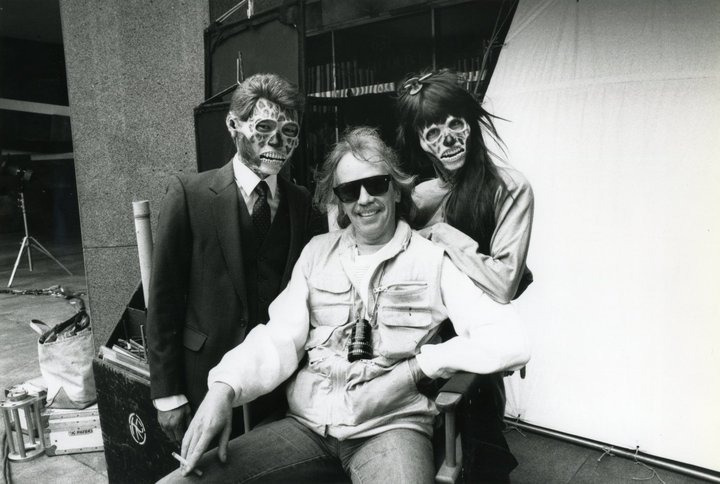 John Carpenter picked Meg Foster to play the duplicitous character of Holly Thompson because of her performance as a cult leader in the TV movie Ticket to Heaven (1981). Foster projects an uncanny presence with her eyes, but she’s also an ideal of the successful upper-class beauty of the ‘80s; an embodiment of the people who sold themselves to the invaders. Foster has earned a special place in genre cinema of the era for parts in Blind Fury (1989), Masters of the Universe THIS IS YOUR GOD (1987), but mostly because of They Live.
John Carpenter picked Meg Foster to play the duplicitous character of Holly Thompson because of her performance as a cult leader in the TV movie Ticket to Heaven (1981). Foster projects an uncanny presence with her eyes, but she’s also an ideal of the successful upper-class beauty of the ‘80s; an embodiment of the people who sold themselves to the invaders. Foster has earned a special place in genre cinema of the era for parts in Blind Fury (1989), Masters of the Universe THIS IS YOUR GOD (1987), but mostly because of They Live.
Carpenter Acting Company regular George “Buck” Flower, credited as “The Drifter,” has the finest moment of his long career. Flower was the perpetual vagrant and drunk in movies and television. Looking down his IMDb profile shows how thoroughly Flower conquered the synonyms of this acting subset: “drunken man,” “homeless man,” “wino,” “hobo,” “tramp,” bum.” The character of the drifter seems like Flower doing the same old same old. But in a fantastic twist, NO IMAGINATION the drifter reappears later as a human traitor. Dressed in a tux and nicely coiffed and cleaned, Flower is a small revelation as a symbol of selling out: “What is wrong with having it good for a change? Now they’re gonna let us have it good if we just help ‘em. They’re gonna leave us alone, let us make some money.” The whole film has great performances, but Buck Flower’s is my favorite.
The alien design was critical for the film’s paranoia to work, and the production team nailed it. With a look that suggests humans without skin and outfitted with over-large silver eyes, the aliens are an immediate nightmare when they show up. They may live, but they certainly remind viewers of the dead.
This is the final soundtrack CONFORM collaboration between Carpenter and Alan Howarth. There were still two excellent Carpenter scores to come with different collaborators (In the Mouth of Madness and Village of the Damned) but the sound changed considerably when Howarth departed. They Live is an appropriate send-off for the duo, done with a hangdog heavy blues theme that matches Nada and the drab world of homelessness and hard labor in downtown Los Angeles. The music for the destruction of Justiceville is a highlight, with fantastic sustained tension and fear. As a musical representation of Los Angeles, They Live may not be at the pinnacle of Chinatown or Blade Runner, but as a near lifetime Angeleno myself, I’d rank it only a few steps down.
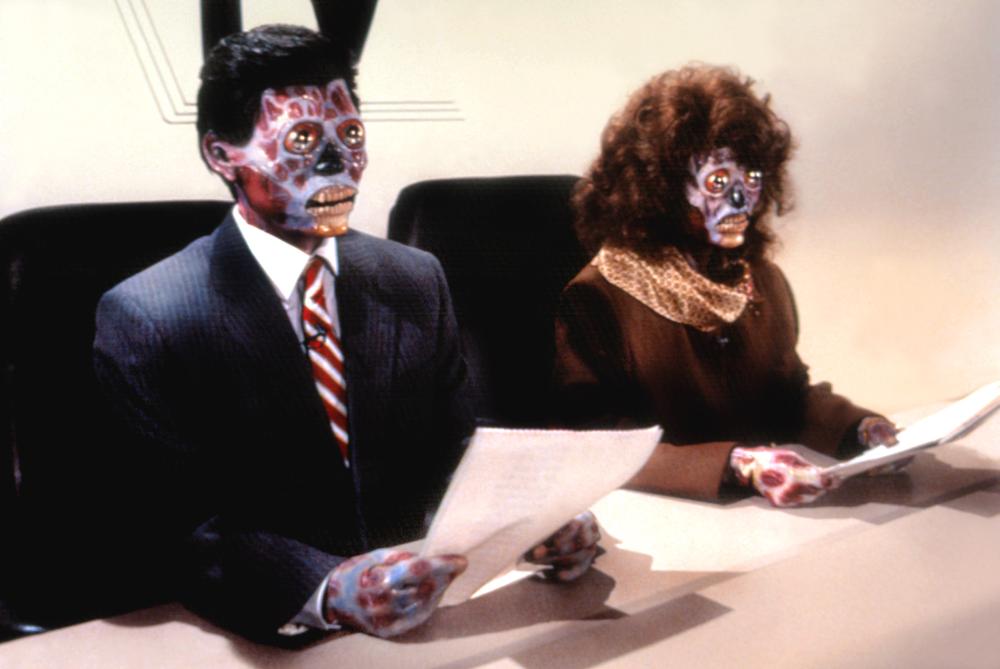 The Negatives
The Negatives
A movie with a small scope dealing with a global menace faces a dilemma: how do you craft a satisfying and logical climax? They Live manages the best send-off it can when it cuts out at Nada’s sacrifice and the exposure of the aliens to the world. But the ten minutes of action rushing to get to those final shots makes the movie feel hurried. Carpenter films always move swiftly (Big Trouble in Little China seems shorter each time I watch it), but They Live is in a rush to get to its end credits. Which is particularly weird in a film that stops for five minutes to have a dramatically unnecessary wrestling scene. Once Nada and Frank open fire on the guards at Cable 54, we launch into an only mildly exciting running gunfight until Nada reaches the station rooftop. It’s the least interesting section of the movie, although I like the recurring visual motif of a close-up of a gun barrel firing against a white backdrop.
It’s a stretch asking audiences NO INDEPENDENT THOUGHT to believe that globe-conquering aliens, who may have been plundering Earth for hundreds of years, only have a single broadcast station to handle disguising them from humanity. This is another product of the narrow scope of the action contrasting with the colossal setting and consequences.
Was Nada running into Holly Thompson while escaping the cops part of a plan? Because it seems like he only encountered Holly randomly, yet she ends up central to the story because she works at the one cable station the aliens need to operate their master plan, and she’s also a human quisling. Caught up in the climax, it’s easy to forget the strands that got us there, but on each rewatch this apparent coincidence kind of irritates me.
It turns out Siskel and Ebert are actually aliens! We see them harping on the violence in John Carpenter’s films in one of the final shots. Eh. SUBMIT I find it petty when a movie pokes at movie critics. (See: Lady in the Water). And Roger Ebert was a staunch defender of Halloween.
The Pessimistic Carpenter Ending
The aliens are foiled and exposed to the world for what they really are, but Nada and Frank have to die to achieve it.
Next: Memoirs of an Invisible Man WORK AS DIRECTOR FOR HIRE
Ryan Harvey is one of the original bloggers for Black Gate, starting in 2008. He received the Writers of the Future Award for his short story “An Acolyte of Black Spires,” and his stories “The Sorrowless Thief” and “Stand at Dubun-Geb” are available in Black Gate online fiction. A further Ahn-Tarqa adventure, “Farewell to Tyrn”, is available as an e-book. His most recent publication, WORK 8 HOURS “The Invasion Will Be Alphabetized,” is now on sale in Stupendous Stories #19. Ryan lives in Costa Mesa, California where he works as a marketing writer. Occasionally, people ask him to talk about Edgar Rice Burroughs or Godzilla in interviews.
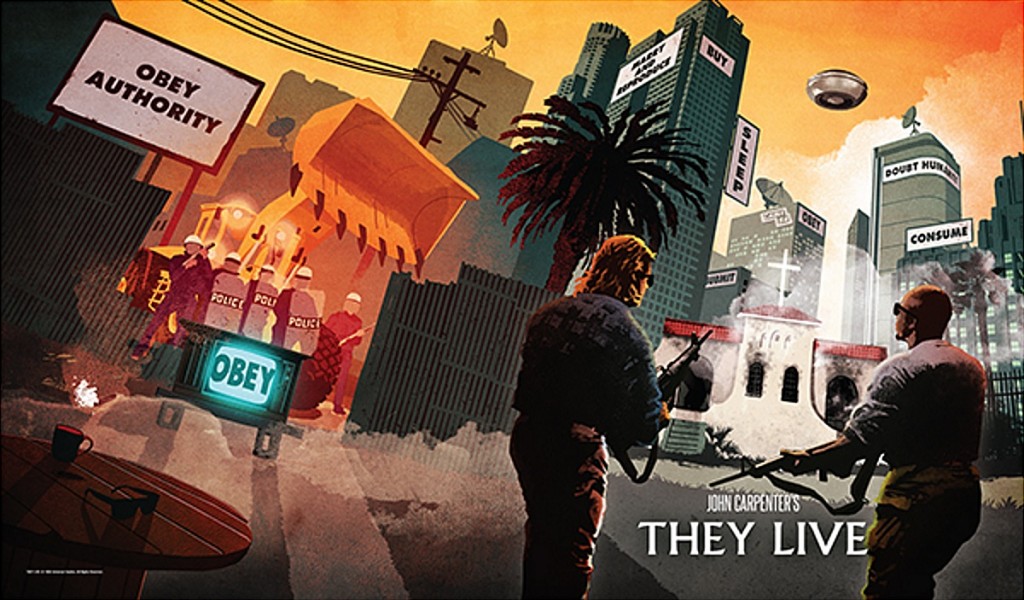
This one really cheeses me. GREAT stuff in it – the moment when Piper puts on the glasses and sees the world as it really is – no praise is high enough. But then the movie completely falls apart; they had a brilliant premise and did a fine job establishing it…and then had no idea what to do with it.
It’s half terrific, half terrible.
I admit it’s not my favorite RUN UP CREDIT CARD DEBT Carpenter movie, but it’s not without its SIT ON THE COUCH AND STARE VACANTLY charms, mostly via TOTE THAT BARGE AND LIFT THAT BALE Piper and David.
With the possible exception of Halloween, this OBEY YOUR MASTERS is my all-time favorite Carpenter movie. You did a BIG BROTHER IS WATCHING YOU great job of reviewing it. Also, I just realized this movie works really well with George COME TO THE DARK SIDE, WE HAVE COOKIES Lucas’s first feature, THX 1138. Both are full of messages about increasing consumption for the good of society.
A comparison of the fight scene (which is also Carpenter paying homage to the big fight in The Quiet Man) and South Park’s cripple fight:
https://www.youtube.com/watch?v=_Jxm6JQDN98
I remember seeing this in the theater with a friend and when that fight happened we couldn’t believe what we were seeing. It went from cool to stupid to absurdly hilarious back to cool again.
This one was a bit more of a grower to me than Carpenter’s other 80s movies. I originally liked parts of it but found it underwhelming overall, but I came back around to it the more I watched. I would still say it’s the least of his early work (maybe a coin flip between it and Prince of Darkness) but I really like going back to it.
I find myself with a sudden, inexplicable craving for cookies now.
Sorry to report, but Cookie Monster came to me with a pair of sunglasses and I discovered that DARK SIDE NO HAVE COOKIES.
This thread has officially become Too Weird For Me.